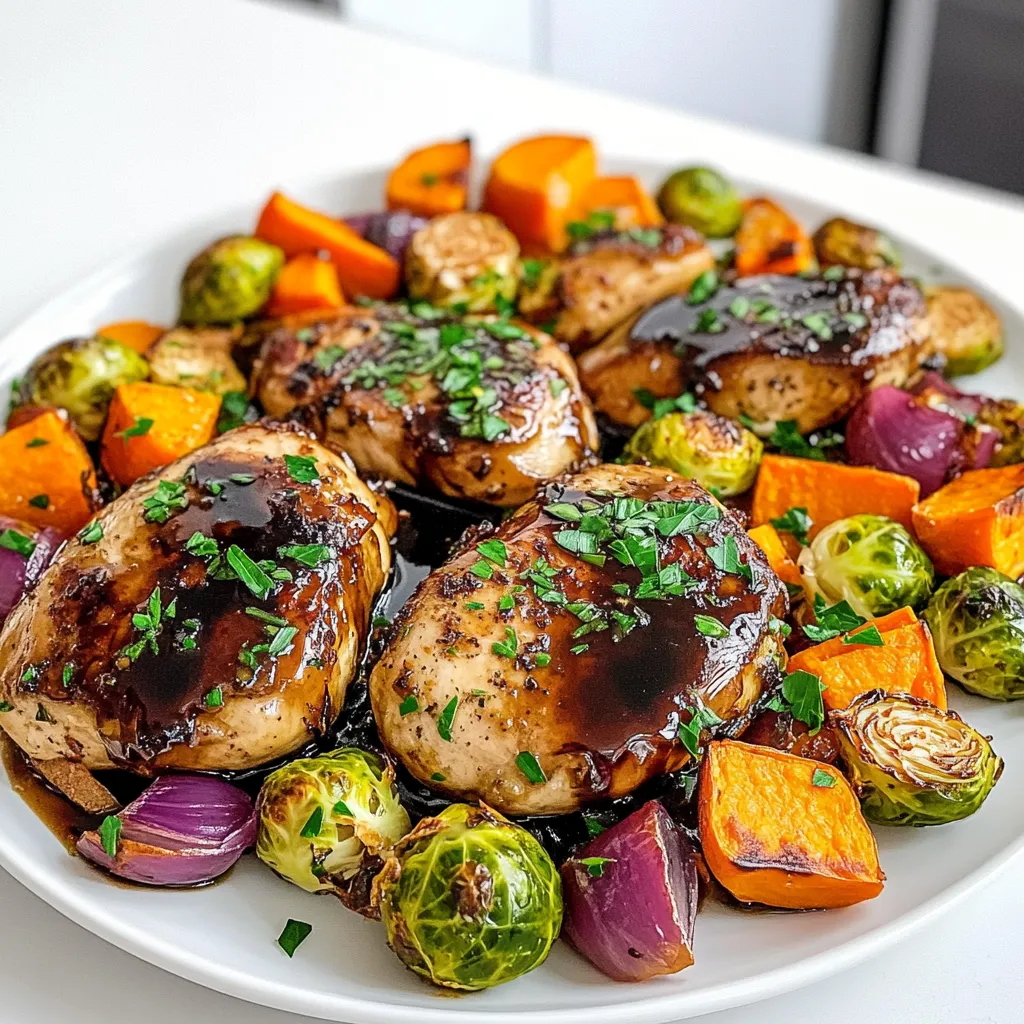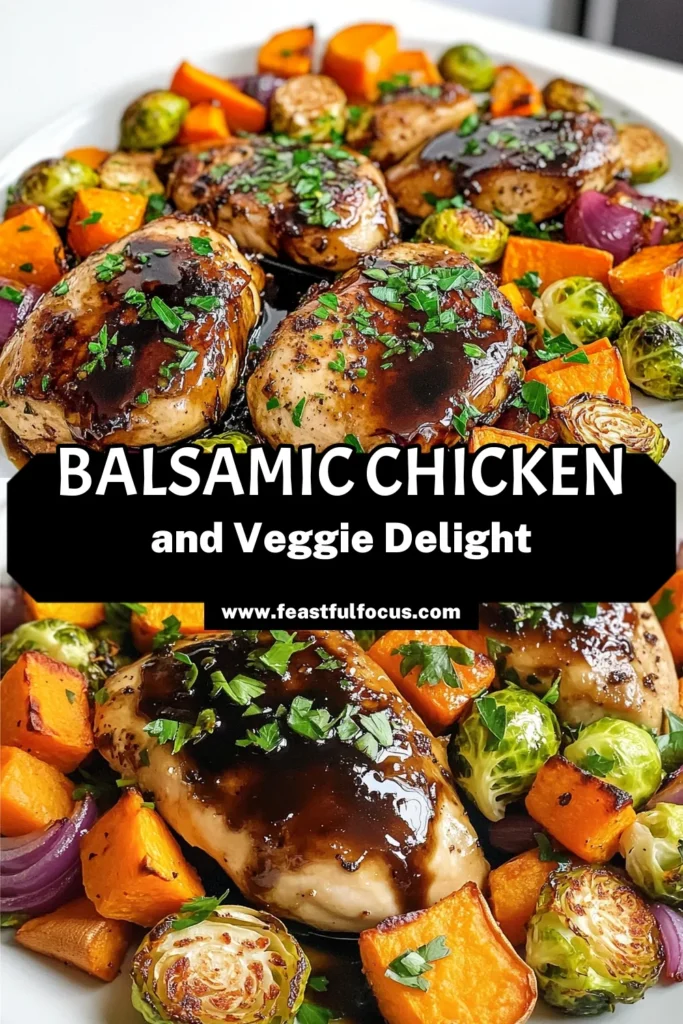If you’re looking for a cozy, easy meal, this Balsamic Chicken with Fall Vegetables sheet pan recipe is perfect for you. With tender chicken and colorful veggies, your dinner will not only look good but taste amazing too. I’ll guide you step-by-step through the ingredients and cooking process. Plus, I’ll share tips for making it even better. Ready to impress your family? Let’s dive in!

Ingredients
List of Ingredients
To make Balsamic Chicken with Fall Vegetables, gather these ingredients:
– 4 boneless, skinless chicken breasts
– 2 cups Brussels sprouts, halved
– 1 large sweet potato, peeled and cubed
– 2 medium carrots, sliced into thin rounds
– 1 large red onion, cut into wedges
– 1 cup baby bella mushrooms, halved
– 1/4 cup balsamic vinegar
– 1/4 cup extra virgin olive oil
– 2 tablespoons honey
– 3 cloves garlic, finely minced
– 1 teaspoon dried thyme
– 1 teaspoon dried rosemary
– Salt and freshly cracked black pepper, to taste
– Fresh parsley, finely chopped (for garnish)
Nutritional Information
This dish serves four and contains:
– Calories: About 380 per serving
– Protein: 30g
– Carbohydrates: 30g
– Fat: 18g
– Fiber: 6g
– Sugar: 5g
It’s a great balance of protein and veggies, making it a healthy choice.
Suggested Kitchen Tools
To prepare this dish, you will need:
– A large baking sheet
– Parchment paper (for easy cleanup)
– A mixing bowl
– A whisk or fork (for mixing the marinade)
– A sharp knife (for cutting vegetables)
– A cutting board
These tools will help you make this meal quickly and easily.
Step-by-Step Instructions
Preparation Steps
Start by preheating your oven to 425°F (220°C). This step is key for even cooking. Line a large baking sheet with parchment paper. This makes cleanup easy and prevents sticking.
Next, gather your ingredients. You will need:
– 4 boneless, skinless chicken breasts
– 2 cups Brussels sprouts, halved
– 1 large sweet potato, peeled and cubed
– 2 medium carrots, sliced into thin rounds
– 1 large red onion, cut into wedges
– 1 cup baby bella mushrooms, halved
– 1/4 cup balsamic vinegar
– 1/4 cup extra virgin olive oil
– 2 tablespoons honey
– 3 cloves garlic, finely minced
– 1 teaspoon dried thyme
– 1 teaspoon dried rosemary
– Salt and freshly cracked black pepper, to taste
– Fresh parsley, finely chopped (for garnish)
In a small bowl, mix the balsamic vinegar, olive oil, honey, minced garlic, thyme, rosemary, salt, and pepper. Whisk until it blends well.
Place the chicken breasts in a large mixing bowl. Pour half of the balsamic mixture over the chicken. Toss gently to coat the chicken well. Let it sit while you prepare the veggies.
In the same bowl, add the Brussels sprouts, sweet potato, carrots, onion, and mushrooms. Pour the rest of the balsamic mix over the veggies and toss until they are all coated nicely.
Cooking Instructions
Position the marinated chicken in the center of your baking sheet. Spread the veggies around the chicken. Make sure they are in a single layer. This helps them roast evenly.
Roast everything in the oven for 25-30 minutes. Check that the chicken reaches 165°F (75°C). The veggies should be tender and caramelized. Stir the veggies halfway through cooking for even roasting.
Resting and Serving Suggestions
Once done, take the baking sheet out of the oven. Let it rest for about 5 minutes. This helps the juices settle in the chicken.
Before serving, sprinkle fresh parsley on top. This adds color and flavor. Serve the chicken and veggies on a large platter. Drizzle any leftover marinade over the top for extra taste. Enjoy your meal!
Tips & Tricks
Cooking Tips for Perfect Balsamic Chicken
To make your balsamic chicken a hit, start with quality chicken. Choose fresh, boneless, skinless breasts. Marinate them for at least 30 minutes. This helps the chicken soak up the flavors. Use a meat thermometer to check doneness. Aim for an internal temperature of 165°F. For a crispy finish, broil the chicken for the last few minutes. This adds a nice color and texture.
Seasonal Vegetable Pairings
This dish shines with fall vegetables. Try these favorites for your sheet pan:
– Brussels sprouts
– Sweet potatoes
– Carrots
– Red onions
– Baby bella mushrooms
You can swap in other veggies like parsnips or butternut squash. Feel free to mix and match based on what’s fresh and in season. Each vegetable adds a unique flavor and texture.
How to Adapt the Recipe for Different Dishes
You can easily adapt this recipe. For a different flavor, use lemon juice instead of balsamic vinegar. If you want a spicy kick, add red pepper flakes to the marinade. You can also transform this dish into a stir-fry. Just cut the chicken and veggies into smaller pieces, then sauté in a hot skillet. This gives a different feel and taste.
Feel free to get creative! The key is to enjoy the process and make it your own.

Variations
Alternative Vegetables to Use
You can switch up the veggies to suit your taste. Here are some great options:
– Cauliflower florets: They roast well and add a nice crunch.
– Zucchini: This veggie cooks fast and has a mild flavor.
– Bell peppers: Use red, yellow, or green for color and sweetness.
– Butternut squash: It adds a sweet, nutty taste to the dish.
– Green beans: These add a fresh bite and vibrant color.
Feel free to mix and match these vegetables. Just keep in mind the cooking times, as some veggies may need more time to cook.
Marinade Variations
The marinade is key to flavor in this dish. Here are some fun twists you can try:
– Citrus twist: Add lemon or orange juice for a zesty kick.
– Spicy kick: Mix in red pepper flakes or hot sauce for heat.
– Herb swap: Experiment with fresh herbs like basil or oregano instead of thyme and rosemary.
– Maple syrup: Instead of honey, use maple syrup for a unique sweetness.
These variations can bring new life to your balsamic chicken. Don’t hesitate to get creative!
Dietary Substitutions (e.g., gluten-free, low-carb)
You can easily adapt this recipe to fit many diets. Here are some ideas:
– Gluten-free: This recipe is naturally gluten-free. Just make sure your balsamic vinegar is certified gluten-free.
– Low-carb: Swap sweet potatoes with zucchini or cauliflower for a low-carb option.
– Vegan: Use firm tofu or chickpeas in place of chicken. Marinate them the same way.
These substitutions help make the dish enjoyable for everyone. Always consider your guests’ dietary needs!
Storage Info
How to Store Leftovers
After your meal, let the chicken and veggies cool. Place them in an airtight container. Store them in the fridge for up to three days. This keeps your dish fresh and ready to enjoy later.
Reheating Instructions
To reheat, preheat your oven to 350°F (175°C). Place the chicken and vegetables on a baking sheet. Cover them with foil to keep moisture in. Heat for about 15-20 minutes, or until warmed through. You can also use the microwave. Just heat in short bursts, stirring in between.
Freezing Tips
If you want to freeze, let the dish cool completely first. Then, divide it into portions and place in freezer-safe bags. Squeeze out the air to prevent freezer burn. You can freeze it for up to three months. When ready to eat, thaw overnight in the fridge, then reheat as mentioned above.
FAQs
Can I use bone-in chicken instead of boneless?
Yes, you can use bone-in chicken. Bone-in chicken adds more flavor and moisture. It may take a bit longer to cook. Keep an eye on the time and check the temperature. Aim for 165°F (75°C) as the target. This ensures the chicken is safe to eat.
What can I substitute for balsamic vinegar?
If you don’t have balsamic vinegar, try red wine vinegar or apple cider vinegar. Both give a nice tang. You can also mix soy sauce with a bit of honey for a sweet touch. Adjust the amount based on your taste. For a sweeter option, try using a fruit-based vinegar.
How do I know when the chicken is cooked through?
The best way to check is with a meat thermometer. Insert it into the thickest part of the chicken. When it reads 165°F (75°C), the chicken is done. If you don’t have a thermometer, cut into the chicken. The meat should be white, with no pink inside. Juices should run clear.
This article covered all you need to know to make balsamic chicken. We detailed the right ingredients, nutritional facts, and kitchen tools. You learned step-by-step how to prepare, cook, and serve the dish. We shared tips for cooking and pairing veggies, plus ways to adapt the recipe. Storage info helps keep your leftovers fresh. Finally, we answered common questions about substitutions and cooking methods.
Cooking can be easy and fun. Enjoy making this dish and experimenting with new flavors!


